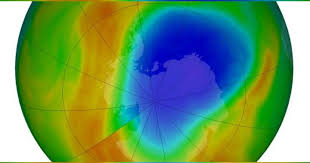The world has some good news to look forward to amid the novel coronavirus outbreak: a hole in the ozone layer is in recovery.
Source: Global News
According to New Scientist, a hole in the ozone layer above Antarctica has continued to recover, leading to changes in atmospheric circulation.
The ongoing recovery has, according to ScienceAlert, stopped many dangerous changes in the Southern Hemisphere’s atmosphere.
In the late 1980s, ozone depletion was driving southern air currents further south, causing a change in rainfall patterns and ocean currents, the publication reports.
The changes suggest the 1987 Montreal Protocol, which banned the production of ozone-depleting substances, is finally working.
New satellite observations and climate simulations, shared in a Science Daily research paper on Wednesday, show that the changing wind patterns have led to the ozone layer’s recovery, according to Antara Banerjee of the University of Colorado Boulder and her colleagues.
Banerjee added that the ozone layer is expected to fully recover to 1980s levels by the 2030s in the Northern Hemisphere and by the 2050s in the Southern Hemisphere. The particular Antarctic hole in question is expected to recover by the 2060s.
New Scientist points out that ozone-depleting substances have a long lifetime, meaning full recovery of the ozone layer won’t happen for another few decades.
This news isn’t intrinsically connected to the COVID-19 outbreak and the subsequent halting of harmful industry practices, but some positive environmental impacts have occurred because of the worldwide decrease in emissions.
In an attempt to slow the rapid spread of COVID-19, economic activity has been hugely limited, resulting in a decline in CO2 emissions, the World Meteorological Organization (WMO) said on Friday.
In a statement, the WMO said cuts in emissions don’t mean the world must stop its fight against climate change.
A study conducted by Severe Weather Europe says the world typically sees an increase in CO2 emissions in the colder months in the Northern Hemisphere. However, this year has been different.
“We are noticing an interesting development, as the CO2 levels are currently increasing at a much slower rate than expected,” the study’s authors wrote.
“Looking at the last 12 months of CO2 data from Mauna Loa observatory (in Hawaii), we can see the CO2 rise last year and this season, which shows slower growth than expected.”
On Twitter, Kris Karnauskas, a climate scientist at the University of Colorado Boulder, suggested the lower emissions could be linked to reduced economic activity amid the pandemic but cautioned that this was not certain.
“I’m not certain this is caused by #COVID19 but there have only been two years since 1975 when CO2 rose less since the first of the year,” Karnauskas wrote.
Countries practising extreme lockdown due to the COVID-19 pandemic, like Italy and China, have seen a drastic decline in air pollution.
Source: Global News

































Leave a Comment
You must be logged in to post a comment.